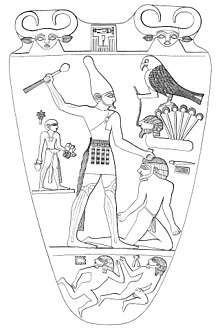First Dynasty of Egypt
The First Dynasty of ancient Egypt (Dynasty I)[1] covers the first series of Egyptian kings to rule over a unified Egypt. It immediately follows the unification of Upper and Lower Egypt, possibly by Narmer,[2] and marks the beginning of the Early Dynastic Period, a time at which power was centered at Thinis.
First Dynasty of Egypt | |||||||||
|---|---|---|---|---|---|---|---|---|---|
| ca. 3100 BC–ca. 2900 BC | |||||||||
.jpg) Narmer Palette (circa 3200-3000 BCE) | |||||||||
| Capital | Thinis | ||||||||
| Common languages | Egyptian language | ||||||||
| Religion | ancient Egyptian religion | ||||||||
| Government | Absolute monarchy | ||||||||
| Historical era | Bronze Age | ||||||||
• Established | ca. 3100 BC | ||||||||
• Disestablished | ca. 2900 BC | ||||||||
| |||||||||
| Periods and Dynasties of Ancient Egypt | ||||||||||||||||||
|---|---|---|---|---|---|---|---|---|---|---|---|---|---|---|---|---|---|---|
|
All years are BC | ||||||||||||||||||
|
Early
|
||||||||||||||||||
|
||||||||||||||||||
|
||||||||||||||||||
|
||||||||||||||||||
|
||||||||||||||||||
|
||||||||||||||||||
|
||||||||||||||||||
|
||||||||||||||||||
|
Ptolemaic (Hellenistic)
|
||||||||||||||||||
|
See also: List of Pharaohs by Period and Dynasty Periodization of Ancient Egypt | ||||||||||||||||||
The date of this period is subject to scholarly debate about the Egyptian chronology. It falls within the early Bronze Age and is variously estimated to have begun anywhere between the 34th and the 30th centuries BC. In a 2013 study based on radiocarbon dates, the beginning of the First Dynasty—the accession of Narmer (commonly known as Menes)—was placed at 3100 BC give or take a century (3218–3035, with 95% confidence).[3]
The dynasty
Information about this dynasty is derived from a few monuments and other objects bearing royal names, the most important being the Narmer Palette and Narmer Macehead, as well as Den and Qa'a king lists.[4][5][6] No detailed records of the first two dynasties have survived, except for the terse lists on the Palermo Stone. The account in Manetho's Aegyptiaca contradicts both the archeological evidence and the other historical records: Manetho names nine rulers of the First Dynasty, only one of whose names matches the other sources, and offers information for only four of them.[7] Egyptian hieroglyphs were fully developed by then, and their shapes would be used with little change for more than three thousand years.
Large tombs of pharaohs at Abydos and Naqada, in addition to cemeteries at Saqqara and Helwan near Memphis, reveal structures built largely of wood and mud bricks, with some small use of stone for walls and floors. Stone was used in quantity for the manufacture of ornaments, vessels, and occasionally, for statues. Tamarix ("tamarisk" or "salt cedar") was used to build boats such as the Abydos boats. One of the most important indigenous woodworking techniques was the fixed mortise and tenon joint. A fixed tenon was made by shaping the end of one timber to fit into a mortise (hole) that is cut into a second timber. A variation of this joint using a free tenon eventually became one of the most important features in Mediterranean and Egyptian shipbuilding. It creates a union between two planks or other components by inserting a separate tenon into a cavity (mortise) of the corresponding size cut into each component."[8]
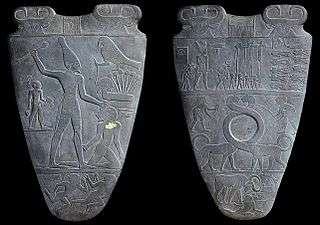 The Narmer Palette
The Narmer Palette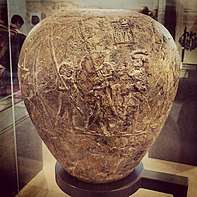
 Necklaces with different types of beads. Carnelian, coral, and garnet.
Necklaces with different types of beads. Carnelian, coral, and garnet.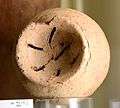 Pottery jar with integral strainer.
Pottery jar with integral strainer.
Human sacrifice
Human sacrifice was practiced as part of the funerary rituals associated with all of the pharaohs of the first dynasty.[9] It is clearly demonstrated as existing during this dynasty by retainers being buried near each pharaoh's tomb as well as animals sacrificed for the burial. The tomb of Djer is associated with the burials of 338 individuals.[9] The people and animals sacrificed, such as donkeys, were expected to assist the pharaoh in the afterlife. For unknown reasons, this practice ended with the conclusion of the dynasty.
Rulers
Known rulers in the history of Egypt for the First Dynasty are as follows:
| Name | Image | Comments | Dates |
|---|---|---|---|
| Narmer |  |
Believed to be the same person as Menes and to have unified Upper and Lower Egypt. | |
| Hor-Aha |  |
Greek form: Athotís. | |
| Djer | 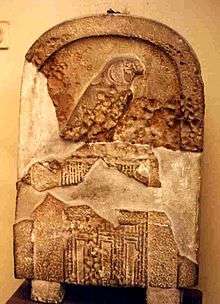 |
Greek form: Uenéphes (after his Gold name In-nebw); His name and titulary appear on the Palermo Stone. His tomb was later thought to be the legendary tomb of Osiris. | |
| Djet | 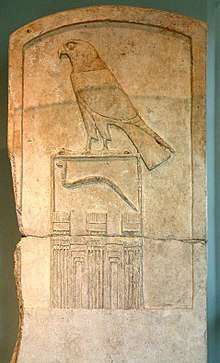 |
Greek form: Usapháis. | |
| Den | 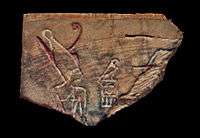 |
Greek form: Kénkenes (after the ramesside diction of his birthname: Qenqen[12]). First pharaoh depicted wearing the double crown of Egypt, first pharaoh with a full niswt bity-name. | |
| Anedjib |  |
Greek form: Miebidós. Known for his ominous nebwy-title.[13] | |
| Semerkhet | 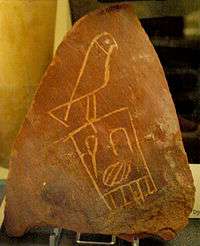 |
Greek form: Semempsés. First Egyptian ruler with a fully developed Nebty name. His complete reign is preserved on the Cairo stone. | |
| Qa'a | Greek form: Bienéches. Ruled very long, his tomb is the last one with subsidiary tombs. | ||
| Sneferka | 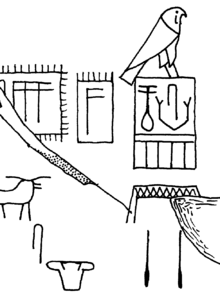 |
Very short reign, correct chronological position unknown. | |
| Horus Bird | 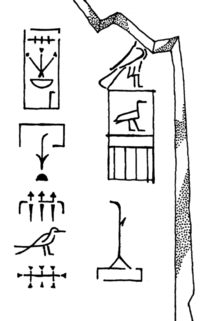 |
Very short reign, correct chronological position unknown. |
See also
- Dynasties of ancient Egypt
- Early Dynastic Period (Egypt)
- Predynastic Egypt
References
Citations
- Kuhrt (1995), p. 118.
- Heagy, Thomas C. (2014). "Who was Menes?". Archeo-Nil. 24: 59–92.CS1 maint: ref=harv (link) Available online "[1]".
- Dee, M.; Wengrow, D.; Shortland, A.; Stevenson, A.; Brock, F.; Girdland Flink, L.; Bronk Ramsey, C. (4 September 2013). "An absolute chronology for early Egypt using radiocarbon dating and Bayesian statistical modelling". Proceedings of the Royal Society A: Mathematical, Physical and Engineering Sciences. 469 (2159): 20130395–20130395. doi:10.1098/rspa.2013.0395. PMC 3780825. PMID 24204188.
- "Qa'a and Merneith lists", Xoomer, IT: Virgilio.
- The Narmer Catalog http://narmer.org/inscription/1553
- The Narmer Catalog http://narmer.org/inscription/4048
- Manetho, Fr. 6, 7a, 7b. Text and translation in Manetho, translated by W.G. Waddell (Cambridge: Harvard University, 1940), pp. 27–35
- "Early ship construction – Khufu's solar boat", Egypt (Timeline), IL: Reshafim, January 2001, retrieved October 29, 2008.
- Shaw (2000), p. 68.
- Wolfgang Helck: Untersuchungen zur Thinitenzeit (= Ägyptologische Abhandlungen (ÄA), Vol. 45). Harrassowitz, Wiesbaden 1987, ISBN 3-447-02677-4, p. 124.
- Wolfgang Helck: Untersuchungen zur Thinitenzeit (Agyptologische Abhandlungen), ISBN 3-447-02677-4, O. Harrassowitz (1987), p. 124
- William Matthew Flinders Petrie: The Royal Tombs of the Earliest Dynasties. Cambridge University Press, New York 2013 (reprint of 1901), ISBN 1-108-06612-7, p. 49.
- Nicolas-Christophe Grimal: A History of Ancient Egypt. Blackwell, Oxford UK/ Cambridge USA 1992, ISBN 978-0-631-19396-8, p. 53.
Bibliography
- Kuhrt, Amélie (1995), The Ancient Near East: c. 3000–330 BCE, London: Routledge, ISBN 978-0-415-01353-6.
- Shaw, Ian (2000), The Oxford History of Ancient Egypt, Oxford: Oxford University Press, ISBN 0-19-280458-8
| Preceded by Pre-dynastic Egypt |
Dynasty of Egypt c. 3100 – 2890 BCE |
Succeeded by Second Dynasty |

